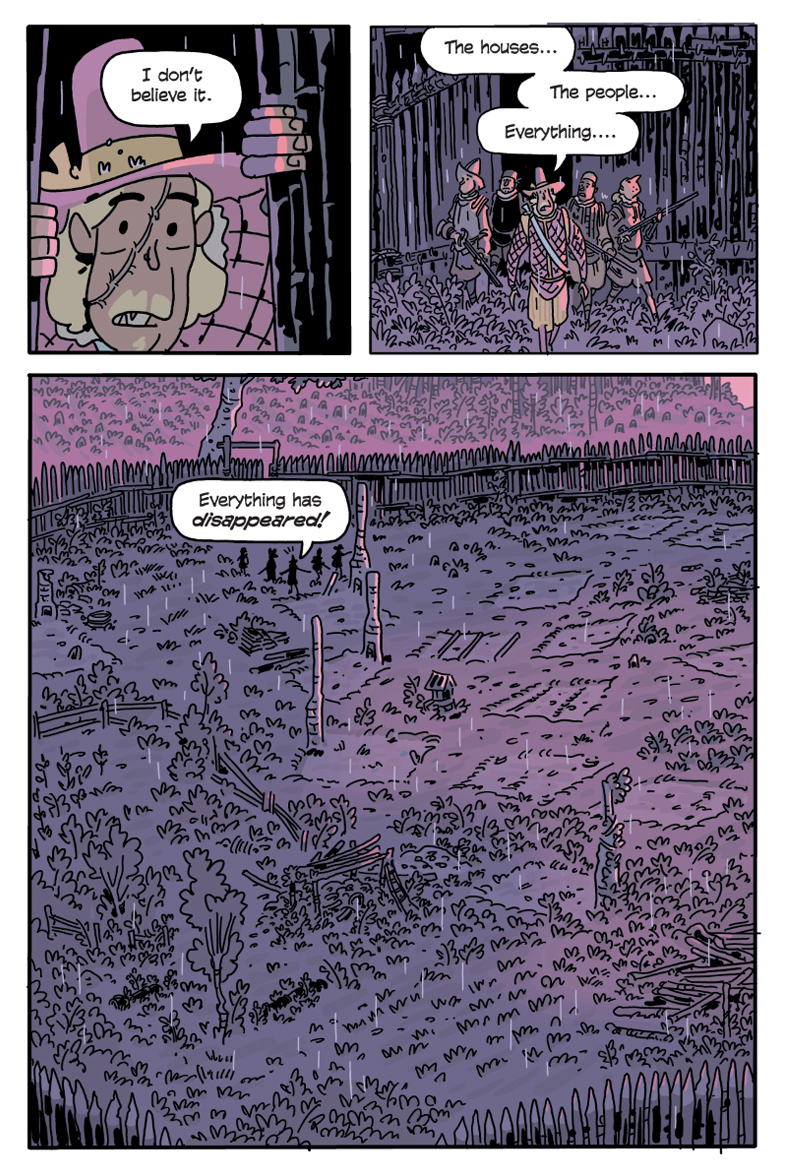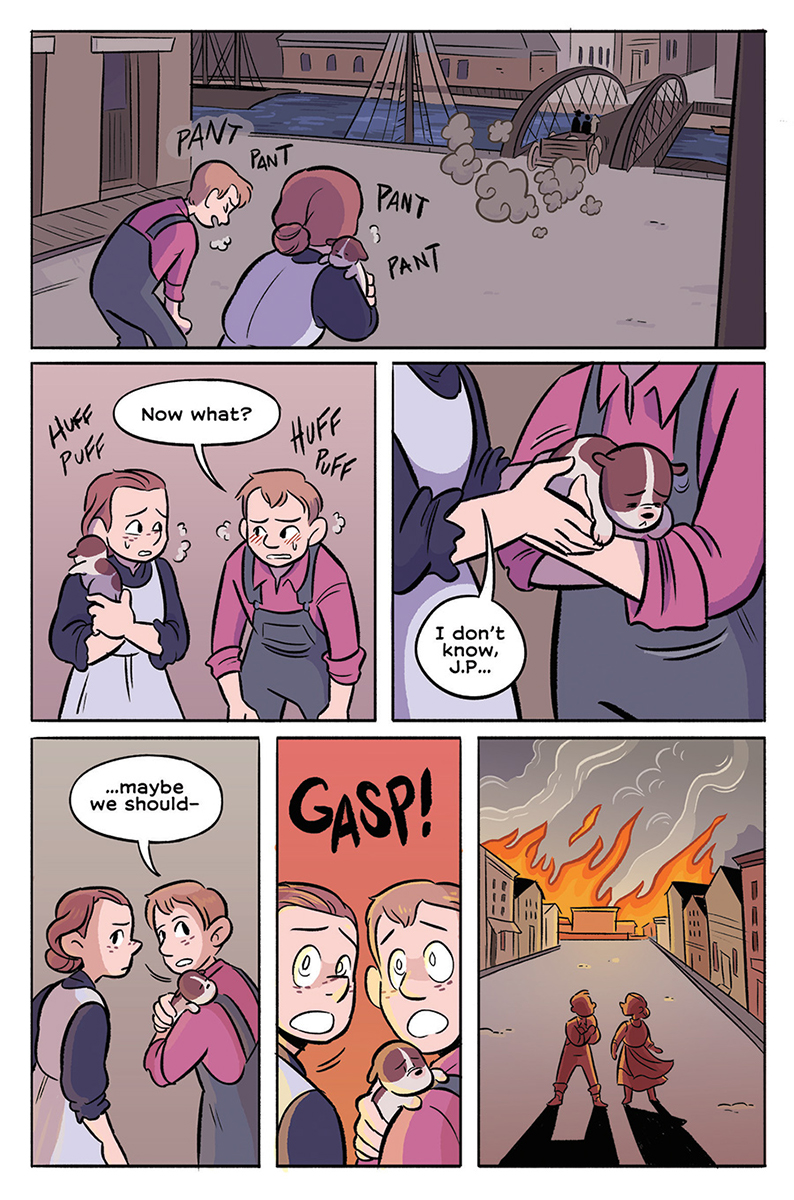First Second Launches History Comics | Stellar Panels
This month’s column kicks off with some breaking news: Graphic novel publisher First Second Books is launching a line of History Comics.
 We’re kicking off this month’s column with some exclusive news: Graphic novel publisher First Second Books is launching a line of History Comics, similar to its Science Comics and Maker Comics lines, but with a focus on American history.
We’re kicking off this month’s column with some exclusive news: Graphic novel publisher First Second Books is launching a line of History Comics, similar to its Science Comics and Maker Comics lines, but with a focus on American history.
Here's the lineup of the first six books (all Gr 4–8), with creative teams and release dates—and we’ve got some exclusive art as well.
- History Comics: The Roanoke Colony Mystery by Chris Schweizer (6/30/20)
- History Comics: The Great Chicago Fire by Kate Hannigan and Alex Graudins (6/30/20)
- History Comics: The Challenger Disaster by Pranas T. Naujokaitis (Fall 2020)
- History Comics: Rosa Parks and Claudette Colvin by Tracey Baptiste and Shauna J. Grant (Winter 2021)
- History Comics: Mustangs by Chris Duffy and Falynn Koch (Spring/Summer 2021)
- History Comics: Crazy Horse by Joseph Bruchac and Marty G. Two Bulls Sr. (Fall 2021)
“The folks at First Second started off by creating a long list of inspirational figures and compelling events that helped define our country,” says series editor Dave Roman. “Then we narrowed in on topics I thought would adapt well to the visual medium of comics. I was glad that the publisher agreed with my request that we avoid too much focus on wars and battles (always my least favorite part of history class). I prefer finding the humanity in history and felt the graphic novel format allows people to really connect with the people and events in ways traditional textbooks rarely do,” he says.
For example, Rosa Parks and Claudette Colvin explores the backstory of Parks’s refusal to give up her seat on a bus to a white passenger, which sparked the Montgomery Bus Boycott of 1955–56. “I was particularly excited to work on a book about Parks and Colvin because they are clear examples of how time tends to whitewash history,” Roman says.
“Not enough people know that a self-motivated teenager named Claudette Colvin protested bus segregation first (but was later ignored by social activists because she didn’t seem like a sympathetic enough personality to become the face of the civil rights movement). Or that Rosa Parks had a history of social activism long before her infamous ride that set off the Montgomery Bus Boycott. She was far from the innocent old lady that she has become characterized as (even in a recent episode of Doctor Who), and in my view, her real life struggles and desire to instigate change are far more interesting and relevant to what’s happening in the world today.”
As it did with Science Comics, First Second is reaching out to scholars and experts to ensure accuracy, and “authenticity advisors” will review the comics’ cultural depictions.
How would they guard against bias? “Writing history is intrinsically biased,” says Roman, “so we are aiming to counteract some of that traditional bias by including stories that are often left out of national narratives. History is often way more messy and complicated than what we initially learn growing up. Hopefully these books will encourage kids to ask tough questions and dig deeper with an aim toward getting closer to the truth of the matter.”
Like the History Comics, many currently available graphic novels take an offbeat view of historical events, depicting the lives of ordinary people rather than simply present a chronology of battles and leaders. This sort of story can help readers grasp the nuances of living in those times, and the visual aspect enables the creators to jump into the narrative with a minimum of description.
 |
|
A panel from the upcoming graphic novel History Comics: The Roanoke Colony Mystery by Chris Schweizer (6/30/20) |
 |
|
From History Comics: The Great Chicago Fire by Kate Hannigan and Alex Graudins (6/30/20) |
Here’s a look at some other graphic novels that bring the reader deep into American history.
Lewis & Clark by Nick Bertozzi (First Second, 2011)
Gr 7 Up—In the introduction to Lewis & Clark, Nick Bertozzi acknowledges that historians have written many accounts of Lewis and Clark’s travels. But he adds, “it is my hope that something else of equal value is communicated here: the experience of that remarkable expedition.” Indeed, Bertozzi does convey that experience, telling the story through a series of vignettes reflecting different points of view: Lewis and Clark themselves, the other members of the party, and the Native Americans they encounter along the way. Bertozzi includes a bibliography. (Although it doesn’t qualify as American history, I would be remiss not to mention Bertozzi’s Shackleton: Antarctic Odyssey (First Second, 2014), which makes even more extensive use of graphics to convey information.)
Nathan Hale’s Hazardous Tales: Lafayette! by Nathan Hale (Abrams, 2018)
Gr 4–7—Each book in the Nathan Hale’s Hazardous Tales series starts with the historical Nathan Hale on the scaffold, about to give his one life for his country. Each time, he postpones his execution by telling historical tales to the stuffy Redcoat and the bumbling hangman who are with him. (Most of the events he describes are in the past for the reader but in the future for Hale’s three characters.) Hale, the writer, (yes, that’s his real name) laces his stories with cheeky humor, but his books are nuanced and accurate. The ninth volume, Major Impossible (about John Wesley Powell), is due out in December 2019.
Kindred by Octavia Butler, adapted by Damien Duffy and John Jennings (Abrams, 2017)
Gr 9 Up—Although it is fiction, Kindred immerses the reader in the experiences of black people under slavery in a way few other graphic novels do. The main character, Dana, is a black woman living in the 1970s who is transported back in time to the 19th century. Her awareness of what she has lost underscores her experience living among slaves and passing for the slave of her white husband.
Taxes, the Tea Party and those Revolting Rebels: A History in Comics of the American Revolution by Stan Mack (NBM, 2012)
Gr 7 Up—Stan Mack’s slightly subversive account of the American Revolution is written in a conversational tone and illustrated in a loose, cartoony style. While many of the events are familiar (the Stamp Act, the Boston Massacre) Mack’s accounts are fresh, incorporating the perspectives of working people as well as the aristocracy and how the wealthy can, at times, act more in their own interests than those of the country. Although this book was first published in 1994, its message feels very current.
Colonial Comics: New England, 1620-1750 edited by Jason Rodriguez (Fulcrum, 2014)
Colonial Comics: New England, 1750-1775 edited by Jason Rodriguez (Fulcrum, 2017)
Gr 5 Up—These two anthologies collect short stories (mostly 5–10 pages) about life in Colonial America, with little-known stories about women, Native Americans, people of color, and nonconformists. The focus is on social structure, government, religion, and everyday life. Brief essays before each piece provide historical context, and the sources are given at the end of the book.
Brigid Alverson is the editor of the blog "Good Comics for Kids."

RELATED
The Adventures of Invisible Boy
King Cheer
Freshman Year
Continental Drifter
The job outlook in 2030: Librarians will be in demand
The job outlook in 2030: Librarians will be in demand
ALREADY A SUBSCRIBER? LOG IN
We are currently offering this content for free. Sign up now to activate your personal profile, where you can save articles for future viewing





Add Comment :-
Be the first reader to comment.
Comment Policy:
Comment should not be empty !!!